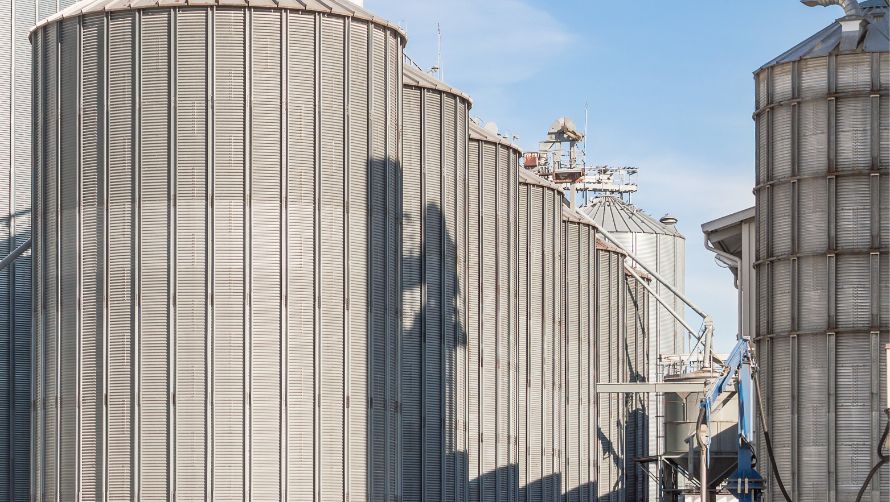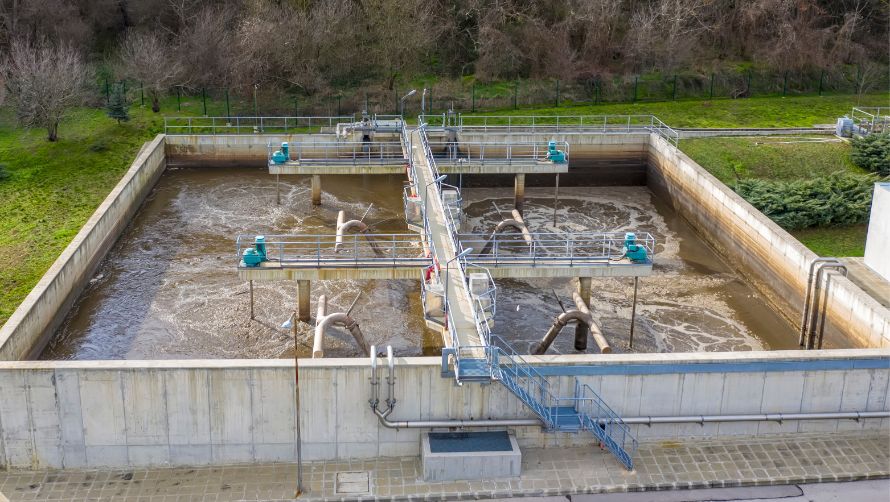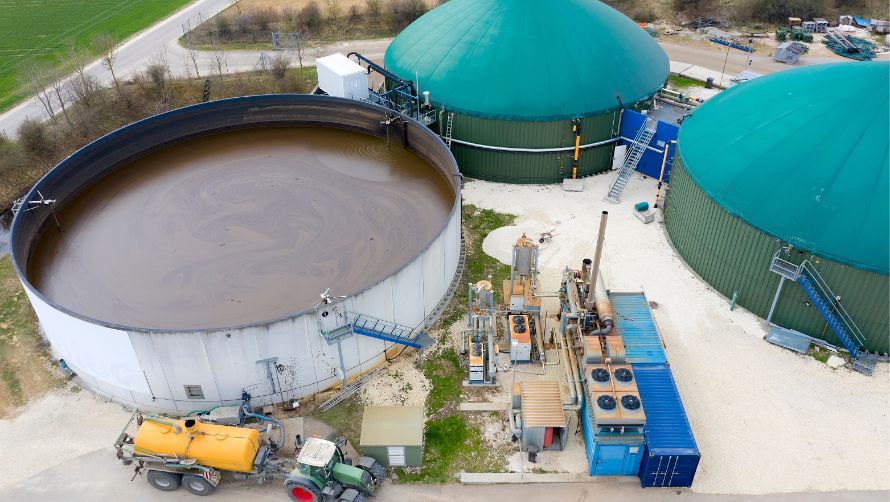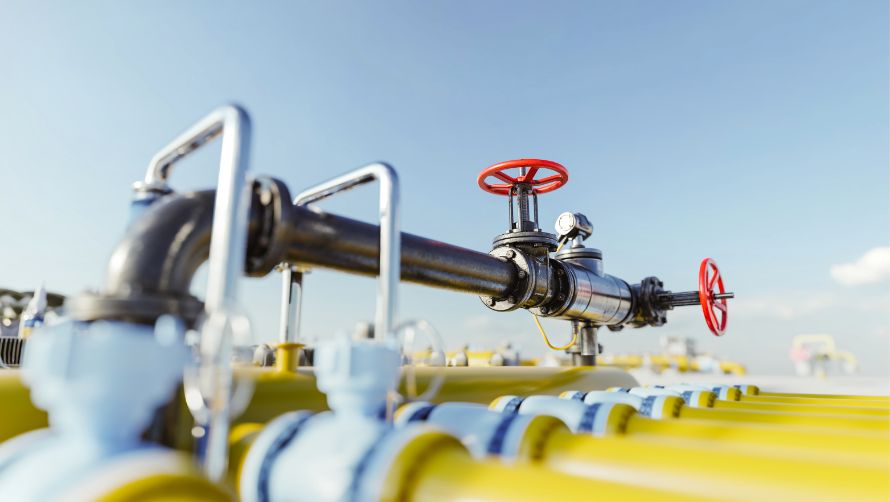The biogas industry plays a vital role in renewable energy production by converting organic waste into valuable biogas through anaerobic digestion. This sustainable fuel is used for power generation, heating, vehicle fuel (Bio-CNG), and more. However, the processes involved—from digestion and purification to compression, storage, and utilization—pose significant safety risks due to the presence of flammable, toxic, & odorous gases like methane (CH₄), hydrogen sulfide (H₂S), ammonia (NH₃), and carbon monoxide (CO).
The Biogas plant encompasses several processes. Here are some of the key processes in the Biogas Plant
Feedstock Handling & Pre-treatment

This process involves the collection, reception, and preparation of organic waste materials such as animal manure, agricultural residues, food waste, and sewage sludge before anaerobic digestion. It includes unloading, screening to remove inorganics, shredding, mixing with water or slurry, homogenization, and optional hygienization (heating to eliminate pathogens). This stage ensures a uniform substrate suitable for efficient digestion and reduces contamination risks.
Types of Gases Present
Ammonia (NH3) – Released from protein-rich materials like manure and food waste; toxic and irritating.
Hydrogen Sulfide (H2S) – Produced from sulfur compounds in organic waste; highly toxic and corrosive.
Methane (CH4) – May accumulate in storage tanks due to partial anaerobic decomposition; highly flammable.
Volatile Organic Compounds (VOCs)– Emitted from decomposing organic matter; odorous and harmful.
Carbon Dioxide (CO2) – Produced by microbial activity; can displace oxygen in confined spaces.
Feedstock Storage Tanks
Microbial activity in stored organic material can cause accumulation of CH₄, NH₃, and H₂S gases. Leaks can occur from tank seals, vents, or overflow points.
Fixed Point Detectors: Install fixed CH₄, NH₃, and H₂S detectors near tank roofs, vents, and outlet pipes to monitor gas buildup.
Portable Detectors: Operators should use portable multi-gas detectors during tank inspection, cleaning, or maintenance activities
Unloading & Reception Pits
Gases like NH₃ and VOCs are released when organic waste is agitated during offloading from trucks or conveyors.
Fixed Point Detectors: : Place fixed NH₃ and VOC detectors at unloading bays and reception pits to continuously monitor emissions.
Portable Detectors: Use portable detectors during unloading or when personnel enter the area for inspection or maintenance.
Mixing & Homogenization Units
Agitation in mixers or homogenizers can cause gas release inside enclosed spaces, primarily CH₄ and H₂S.
Fixed Point Detectors: Fixed CH₄ and H₂S detectors should be installed near mixers, agitators, and slurry pipelines.
Portable Detectors: Maintenance personnel should use portable detectors before entering confined spaces or servicing mixers.
Pumps & Pipelines
Mechanical equipment such as pumps and feed pipelines can leak gases due to worn seals, gaskets, or fittings. CH₄, NH₃, and H₂S are the primary gases of concern.
Fixed Point Detectors: Fixed detectors should be installed near pump housings, flange joints, valve assemblies, and pipeline connections.
Portable Detectors: Portable detectors are recommended for routine leak detection and during repair or maintenance operations
Anaerobic Digestion

Anaerobic digestion is a biological process where microorganisms break down organic material in the absence of oxygen, producing biogas mainly composed of methane (CH₄) and carbon dioxide (CO₂). This process occurs in sealed digesters under controlled temperature and pH conditions. The feedstock from the pre-treatment stage is converted into biogas and digestate (nutrient-rich slurry). The digestion typically lasts from 15 to 30 days, depending on feedstock and operating parameters. Proper mixing is maintained to ensure uniform microbial activity.
Types of Gases Present
Ammonia (NH3) – Can be released in trace amounts from nitrogenous materials.
Hydrogen Sulfide (H2S) – Toxic and corrosive gas formed from sulfur compounds during digestion.
Methane (CH4) – Highly flammable and explosive biogas produced during digestion.
Carbon Dioxide (CO2) – Non-flammable gas produced alongside methane.
Digester Vessel
Potential leak points include seals, manways, agitator shafts, and pressure relief valves where biogas can escape
.Fixed Point Detectors: Fixed CH₄ and H₂S detectors should be installed near digester tops, access points, and ventilation areas.
Portable Detectors: Portable multi-gas detectors should be used during maintenance, inspection, and confined space entry.
Gas Collection Piping & Valves
Leaks may occur at pipe flanges, valve stems, welds, and joints transporting biogas from digesters to storage or utilization points.
Fixed Point Detectors: : Fixed CH₄ and H₂S detectors should be installed along piping routes, especially at connection points and valves.
Portable Detectors: Portable detectors should be used during routine leak checks and maintenance.
Mixing & Agitator Equipment
Mechanical seals and shafts on agitators can leak biogas during operation or servicing.
Fixed Point Detectors: Install fixed CH₄ and H₂S detectors near agitator housings and shaft seals.
Portable Detectors: Use portable detectors during agitator maintenance and before confined space entry.
Biogas Collection & Storage

This process involves the collection of biogas generated in the anaerobic digester and its temporary storage before utilization or upgrading. Biogas is captured through a network of pipes and valves connected to the digester and directed to gas holders or storage tanks. Proper storage maintains safe pressure levels and prevents gas loss or exposure to the atmosphere. The storage system must also handle moisture and corrosive gases like hydrogen sulfide.
Types of Gases Present
Hydrogen Sulfide (H2S) – Toxic and corrosive gas present in raw biogas.
Methane (CH4) – Main combustible gas in biogas; poses fire and explosion risks if leaked.
Carbon Dioxide (CO2) – Non-flammable, can displace oxygen in confined spaces
Gas Collection Piping & Joints
Leaks can occur at pipeline joints, flanges, valves, and welds transporting biogas from digesters to storage.
.Fixed Point Detectors: Install fixed CH₄ and H₂S detectors along gas piping routes, focusing on joints and valves.
Portable Detectors: Use portable detectors for routine leak detection and during maintenance activities.
Gas Holder Seals & Vents
Flexible seals and venting points on gas holders can leak methane and hydrogen sulfide, especially if seals degrade or vents malfunction.
Fixed Point Detectors: : Fixed CH₄ and H₂S detectors should be installed near gas holder seals, vent stacks, and pressure relief valves.
Portable Detectors: Portable detectors should be used during inspection, maintenance, or seal replacement.
Pressure Relief Valves
Safety valves that release excess pressure can leak or vent biogas during operation.
Fixed Point Detectors: Place fixed detectors near pressure relief valves and venting areas.
Portable Detectors: Use portable detectors when servicing or testing relief valves.
Biogas Purification / Upgradation

Biogas purification or upgradation involves removing impurities such as carbon dioxide (CO₂), hydrogen sulfide (H₂S), moisture, and other contaminants from raw biogas to increase the methane content and improve its quality. This purified biomethane can then be used as a renewable natural gas for injection into pipelines or as vehicle fuel. Common technologies include water scrubbing, pressure swing adsorption, chemical absorption, and membrane separation.
Types of Gases Present
Hydrogen Sulfide (H2S) – Toxic and corrosive gas present in raw biogas and during desulfurization.
Methane (CH4) – Main component of biogas; highly flammable and can leak during processing.
Carbon Dioxide (CO2) – Removed during upgrading; may be vented or captured.
Trace VOCs– Volatile organic compounds present in raw biogas.
Upgrading Equipment & Vessels
Potential leak points include vessel seals, pumps, valves, and piping used in scrubbing or absorption units.
.Fixed Point Detectors: Fixed CH₄ and H₂S detectors should be installed near upgrading vessels, pumps, and critical piping connections.
Portable Detectors: Portable detectors must be used during maintenance, inspection, and confined space entry.
Gas Storage after Upgradation
Storage tanks and gas holders for upgraded biomethane can leak methane due to seal or valve failures.
Fixed Point Detectors: : Fixed CH₄ detectors should be installed near storage tank vents, seals, and filling points.
Portable Detectors: Portable detectors are recommended during tank inspections and maintenance.
Gas Compression Units
Compressors used to increase biomethane pressure can leak methane through seals, valves, or flanges.
Fixed Point Detectors: Fixed CH₄ detectors should be installed around compressors and associated piping.
Portable Detectors: Use portable detectors during compressor maintenance and troubleshooting.
Biogas Compression & Bottling (Bio-CNG Applications)

In this process, purified biogas (biomethane) is compressed to high pressures (typically 200–250 bar) to convert it into Bio-CNG (Compressed Natural Gas), which is then filled into high-pressure cylinders for storage, transportation, or commercial use. This involves high-pressure compressors, dryers, cascades, and bottling systems. Due to the high energy content and flammability of methane, this stage is highly sensitive to leaks and demands stringent safety monitoring.
Types of Gases Present
Hydrogen Sulfide (H2S) – May be present in trace amounts; toxic and corrosive.
Methane (CH4) – Main component of Bio-CNG; extremely flammable and explosive under pressure.
Carbon Dioxide (CO2) – Inert but can displace oxygen in confined areas.
High-Pressure Compressors
Compressors can leak methane from seals, valves, piston rings, and pressure lines.
Fixed Point Detectors: Fixed CH₄ detectors should be installed around the compressor area, especially near seals and relief valves.
Portable Detectors: Portable detectors should be used during compressor servicing, seal inspection, and pressure system maintenance.
Cylinder Filling Stations
Leak risks exist at cylinder valve connections, flexible hoses, filling nozzles, and during decoupling.
Fixed Point Detectors: : Install CH₄ detectors at the cylinder filling bay, close to connection points and hose reels.
Portable Detectors: Use portable methane detectors for manual leak checks during and after cylinder filling operations
Cascade Storage Systems
Bottled Bio-CNG stored in cascades (racks of high-pressure cylinders) can leak due to faulty valves, pressure relief devices, or damaged connectors.
Fixed Point Detectors: Place CH₄ detectors near cascade storage units, especially around manifolds and vent outlets.
Portable Detectors: Regular portable gas checks are essential during cascade filling, inspection, and movement.
Biogas Utilization

Biogas utilization refers to the direct use of biogas as a fuel for generating electricity, heat, or both (Combined Heat and Power - CHP). It can be used in gas engines, turbines, or boilers. In some cases, biogas is also used for cooking, lighting, or as fuel in industrial furnaces. Utilizing biogas efficiently reduces dependency on fossil fuels, but combustion and gas handling systems must be carefully monitored to avoid safety hazards.
Types of Gases Present
Hydrogen Sulfide (H2S) – If present in the gas, it may leak or be emitted during combustion.
Methane (CH4) – Unburned methane may leak during supply or combustion; highly flammable.
Carbon Monoxide(CO) – Produced from incomplete combustion; toxic and flammable.
Nitrogen Oxides (NOx) – Emitted as combustion by-products; contribute to air pollution.
Biogas Engines & Turbines
Engines and turbines can leak unburned methane or exhaust gases due to poor sealing or equipment wear.
Fixed Point Detectors: Install CH₄, CO, and H₂S detectors near engine enclosures and exhaust systems.
Portable Detectors: Use portable detectors during engine maintenance, inspections, or fault troubleshooting.
Biogas Boilers
Boilers using biogas may leak fuel during supply or generate hazardous flue gases during combustion.
Fixed Point Detectors: : Place CH₄ and CO detectors near burners, valves, and boiler flue exits.
Portable Detectors: Use portable devices to check for leaks during burner tuning, maintenance, and emergency checks.
Piping and Supply Lines
Leaks may occur at joints, flanges, or valves in the biogas supply system feeding into utilization equipment.
Fixed Point Detectors: Install CH₄ detectors along the gas piping network and near key valve junctions.
Portable Detectors: Perform routine leak surveys with portable detectors and use during maintenance work.
Digestate Handling & Post-treatment

Digestate is the semi-solid or liquid residue left after anaerobic digestion of organic waste. It contains valuable nutrients and is often used as organic fertilizer or soil conditioner. Post-treatment processes such as dewatering, drying, composting, or nutrient recovery are applied to make the digestate easier to handle, store, or transport. Although this stage involves fewer flammable gases, it may emit odorous or toxic gases during handling and treatment.
Types of Gases Present
Hydrogen Sulfide (H2S) – If not fully combusted, can be released; toxic and corrosive.
Methane (CH4) – May leak from flare piping or incomplete combustion.
Carbon Monoxide (CO) – May be produced due to incomplete combustion.
Sulfur Dioxide (SO2)– Generated from combustion of H₂S; toxic in high concentrations.
Digestate Dewatering Units
Equipment such as centrifuges or belt presses may release gases during separation of liquid and solid fractions
Fixed Point Detectors: Install NH₃ and H₂S detectors near dewatering equipment and enclosed areas
Portable Detectors: Use portable detectors during equipment maintenance, cleaning, or inspection.
Digestate Storage Tanks or Lagoons
Open or covered storage units may emit methane, ammonia, or hydrogen sulfide from ongoing microbial activity.
Fixed Point Detectors: : Fixed CH₄, NH₃, and H₂S detectors should be installed around storage tanks, especially near vent points.
Portable Detectors: Use portable gas detectors during tank inspection, agitation, or sludge removal.
Composting/Drying Areas
Digestate drying or composting can emit VOCs, ammonia, and other odorous gases.
Fixed Point Detectors: Place NH₃ and VOC detectors in enclosed or semi-enclosed drying/composting areas.
Portable Detectors: Portable detectors should be used for regular monitoring, especially in poorly ventilated zones.
Flare System / Emergency Gas Disposal

The flare system is a critical safety component in biogas plants, used to safely burn off excess or unusable biogas during system malfunctions, maintenance, or overpressure events. It prevents the release of raw biogas—especially methane and hydrogen sulfide—into the atmosphere. Flares can be open or enclosed and are designed to combust biogas completely, converting it into carbon dioxide and water vapor, with minimal harmful emissions.
Types of Gases Present
Hydrogen Sulfide (H2S) – Emitted from residual organics; toxic and corrosive.
Methane (CH4) – May be released from partially digested material under anaerobic conditions.
Ammonia (NH3) – Released during drying or storage of digestate; pungent and toxic.
Volatile Organic Compounds (VOCs) – Emitted during composting or drying; may cause odor issues.
Flare Stack & Burner Assembly
Leaks can occur at burner nozzles, seals, pilot lines, or ignition systems, especially during startup or shutdown.
Fixed Point Detectors: Install CH₄, H₂S, and CO detectors near the flare base and around the burner assembly.
Portable Detectors: Use portable detectors during flare inspections, ignition system checks, or emergency interventions.
Flare Gas Piping & Control Valves
The gas line delivering biogas to the flare can leak at valves, regulators, or pipe joints due to pressure fluctuations.
Fixed Point Detectors: : Fixed CH₄ and H₂S detectors should be placed along the flare gas pipeline and near critical valve stations.
Portable Detectors: Regular portable leak checks are essential during pressure adjustments, valve maintenance, or gas routing operations.
Vent Stacks & Emergency Bypass
In emergency venting conditions, gas may be released without complete combustion, especially if the flare fails.
Fixed Point Detectors: Place CH₄ detectors around vent stacks or bypass systems to detect unburned gas release.
Portable Detectors: Use portable detectors during emergency bypass operations or when flare is offline for repairs.
